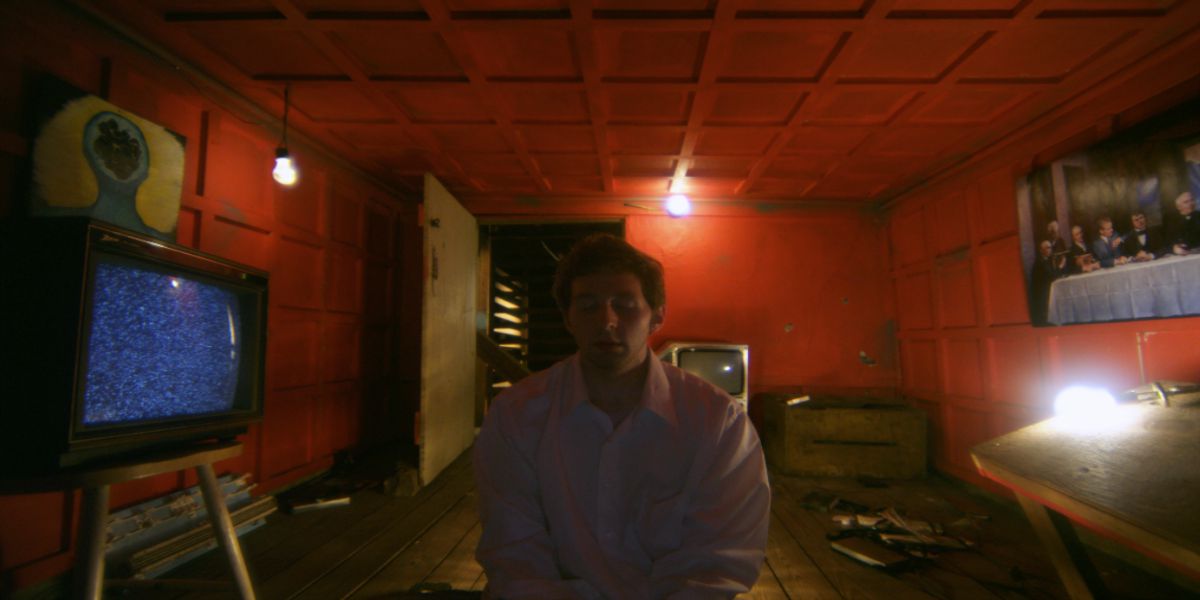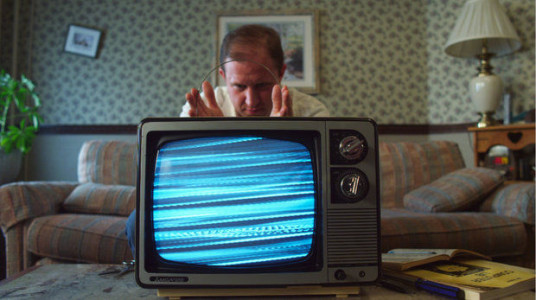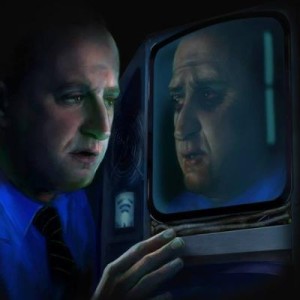It’s 1987, and the internet is in its infancy. This is the setting writer/director Graham Nolte chose to stage Parallax, a wryly comedic drama that explores the connections (or lack thereof) people make through technology. Set long before Facebook, Twitter, Youtube, cellphones, or any of the technology we would normally associate as relevant to our modern day life, Parallax introduces a fictional invention: the telecommunications “revelation” of the Z-TV.
The setup. The opening prologue introduces Abbot Allen (Michael Kelberg), a Princeton professor whose obsessive compulsion to perfect his invention, a mass communication device he dubs the Zeteo Vision (Z-TV) prompts his boss to fire him in 1983. Four years later, Abbot is divorced and unemployed, but still devoted to his vision. The plot focuses on his meandering quest to “revolutionize the industry” with his Z-TV, but also dips into several tangential side stories: Abbot trying to win back his ex wife Lucia (Mary Sarah Agliotta), the mental instability of his brilliant former student Mannix (Robb Stech), his friend Finbar’s (Phillipe Simon) budding romance with a woman he met through Z-TV, and several others.
Visually, the film is cool and crisp, stylized almost as if to reflect that the image we’re watching on our screen is a screen itself. It’s entwined with the film’s themes of the effects of screens in our lives. The Z-TV itself is a network in which people upload videos, because as Abbot forcefully asserts, “text based communication is a thing of the past, and visuals are the future.” Parallax plays with this, superimposing or reflecting the video files from the network over the people who are watching them. It’s a simple, yet innovate way of both incorporating the film’s world and demonstrating how immersive the technology can be.
Like no other indie film. As is to be expected with low budget indie movies, Parallax is a bit rough around the edges, and the script occasionally comes across as forced, such as little interactions with nosy neighbors and the police that are meant to be quirky, but rather play out awkwardly. However, the moments when the film really shines are also due to the script. Nolte has an ear for offhand, clever lines, such as Abbot’s conversation with his ex-wife:
Lucia: “He proposed to me while we were in the Bahamas.”
Abbot: “I thought the Caribbean was another example of cultural genocide?”
Luca: “It’s a nice place to visit too.”
Commentary and reflections. There are also moments of astute commentary and reflections on our current use of social media. Abbot watches several people’s uploads to the network, letting out exasperated sighs and venting his frustration at the banal or self serving content some choose to share, but becomes even more annoyed when he loses the signal and cannot watch anything. The implications for sites like Youtube or Facebook are obvious: Everyone has at one time or another criticized what is shared on it, yet these are the same people who perpetuate the cycle by using it. Yet Parallax is not interested in launching a jeremiad against technology; it explores its effects, both good and bad. Abbot’s friend Finbar is able to make a meaningful human connection through the Z-TV, while others self destruct, use it as impractical therapy, or watch soap operas.
Parallax actually makes great use of soap operas, borrowing from Twin Peaks and creating their own soap opera, Theses are the Moments of Our Times to play out in the background. In a similar fashion, Nolte also makes great use of commercials. One of Abbot’s former students, Mannix, compulsively watches commercials, and almost exclusively uses the Z-TV as a source to upload them. Instead of leaving it at that, Nolte allows us to view several of them, which provide some of the funniest and most memorable bits of the film. The standout is an ad for rice, with an over enthusiastic nuclear family oohing and ahhing over rice like it’s the best thing since sliced bread. Others include a “Vaccomb” (a comb/vacuum), a coffee commercial which overlays a voice-over, “it smells so good you can taste it” over the image of a nose dipping itself into the cup of coffee, and several others. While they do ultimately serve the plot, their presence functions as a humorous way to get across that 1980’s vibe.
The obvious comparison. Like The Social Network, another film about an obsessive technological revolutionary, Parallax is primarily concerned with how our drive to connect and force community through technology has less to do with the technology and more to do with the humans behind it. Abbot’s isolation is the inevitable end of his venture. Non diegetic sound is only occasionally used, but when it is, it’s a few soft, melancholy piano notes playing at key moments in Abbot’s life; he literally begins and ends on a sad note. Not only does the sound hone in on Abbot’s woes, but how the film frames him highlights his alienation. One of the most memorable scenes of the film is when he is pitching his idea to the National Science Board in the hopes of receiving grant money, and Nolte shoots in the scene in a traditional shot reverse shot sequence, which leaves Abbot alone in his frame compared to a crowded frame of the three people he’s talking to across from him. As he pitches the Z-TV with the tagline “no one will ever be alone again,” the frame slowly zooms and compresses the image over his face, highlighting the irony that the inventor of such a machine would himself be so alone.
Parallax allows us to examine our interactions with technology through the lens of the past, painting a compelling period picture that manages to entertain by telling the story of one man in the 1980s, while providing thoughtful commentary that applies to anyone with internet access in the 21st Century. Its darkly comedic style isn’t there to lecture about the evils of technology, but about the failure of technology to function as a tool for salvation.
Parallax (2015) on Vimeo.




